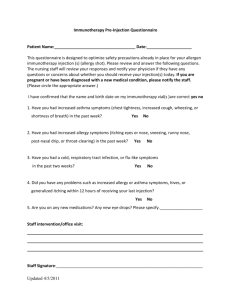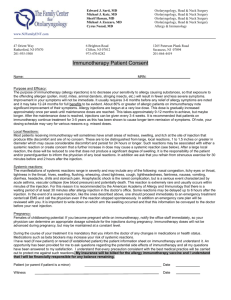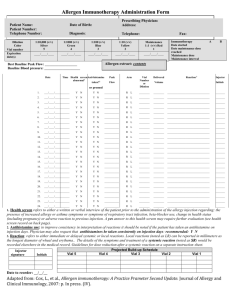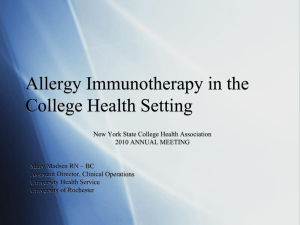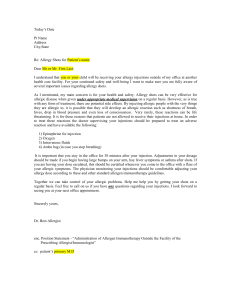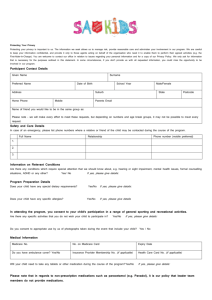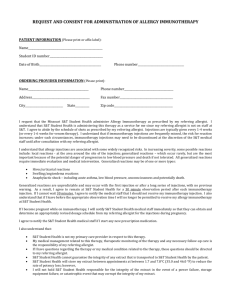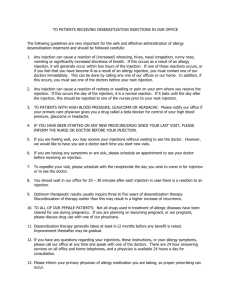Immunotherapy Administration instructions
advertisement
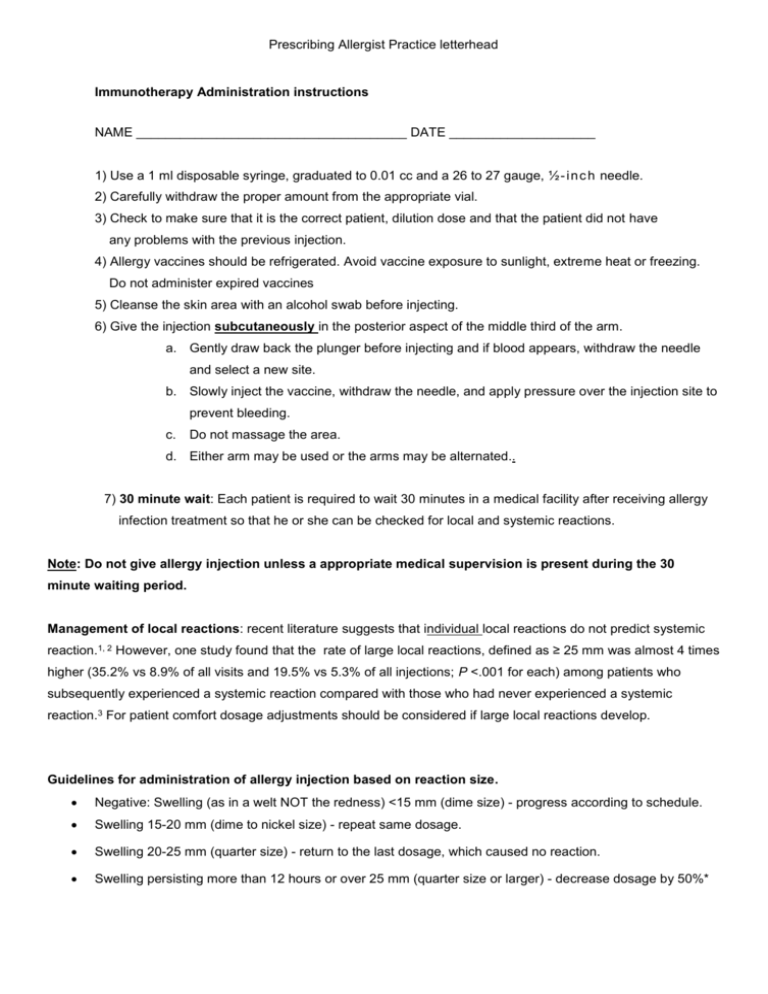
Prescribing Allergist Practice letterhead Immunotherapy Administration instructions NAME _____________________________________ DATE ____________________ 1) Use a 1 ml disposable syringe, graduated to 0.01 cc and a 26 to 27 gauge, ½ - i n c h needle. 2) Carefully withdraw the proper amount from the appropriate vial. 3) Check to make sure that it is the correct patient, dilution dose and that the patient did not have any problems with the previous injection. 4) Allergy vaccines should be refrigerated. Avoid vaccine exposure to sunlight, extreme heat or freezing. Do not administer expired vaccines 5) Cleanse the skin area with an alcohol swab before injecting. 6) Give the injection subcutaneously in the posterior aspect of the middle third of the arm. a. Gently draw back the plunger before injecting and if blood appears, withdraw the needle and select a new site. b. Slowly inject the vaccine, withdraw the needle, and apply pressure over the injection site to prevent bleeding. c. Do not massage the area. d. Either arm may be used or the arms may be alternated.. 7) 30 minute wait: Each patient is required to wait 30 minutes in a medical facility after receiving allergy infection treatment so that he or she can be checked for local and systemic reactions. Note: Do not give allergy injection unless a appropriate medical supervision is present during the 30 minute waiting period. Management of local reactions: recent literature suggests that individual local reactions do not predict systemic reaction.1, 2 However, one study found that the rate of large local reactions, defined as ≥ 25 mm was almost 4 times higher (35.2% vs 8.9% of all visits and 19.5% vs 5.3% of all injections; P <.001 for each) among patients who subsequently experienced a systemic reaction compared with those who had never experienced a systemic reaction.3 For patient comfort dosage adjustments should be considered if large local reactions develop. Guidelines for administration of allergy injection based on reaction size. Negative: Swelling (as in a welt NOT the redness) <15 mm (dime size) - progress according to schedule. Swelling 15-20 mm (dime to nickel size) - repeat same dosage. Swelling 20-25 mm (quarter size) - return to the last dosage, which caused no reaction. Swelling persisting more than 12 hours or over 25 mm (quarter size or larger) - decrease dosage by 50%* Prescribing Allergist Practice letterhead *If reduced dose is tolerated, increase dose by 0.05 to 0.1 cc weekly and resume schedule. If local reaction occurs again, patient should be seen in our office with dosage sheet. Example of Immunotherapy Dose Adjustments for Unscheduled Gaps in Allergen Immunotherapy Injection Intervals There have been no studies that have investigated the effect of dosage modification for gaps in immunotherapy injection intervals. Below is a suggested approach to modification of doses of allergen immunotherapy because of gaps between treatment during the build-up and maintenance phase Build-up phase for weekly or biweekly injections (time intervals from missed injection) Up to 7 days, continue as scheduled ( i.e. if on weekly build-up then it would be up to 14 days after administered injection or 7 days after the missed scheduled injection ): 8 to 13 days after missed scheduled injection; repeat previous dose. 14 to 21 days after missed scheduled injection;, reduce dose 25% 21 to 28 days after missed scheduled injection; reduce previous dose 50% Then increase dose each injection visit as directed on the immunotherapy schedule until therapeutic maintenance dose is reached. Maintenance phase (time intervals from missed injection) Up to 10 days, repeat last dose. 11 to 20 days, reduce dose by 25%. * 21 to 28 days, reduce dose by 50%. * Over 28 days, contact physician for orders. Increase dose by 0.05 cc one injection per week (each vial, if more than one vial) until maintenance is reached, and then resume maintenance schedule. Systemic reactions: Systemic reactions resulting from injections can occur in the course of treating allergic patients. Most reactions occur within 30 minutes after an injection. Symptoms may include itching of the palms of the hands or other parts of the body, sneezing, coughing, hives (welts), swelling of the lips or other areas, and shortness of breath. At the first sign of any systemic reaction epinephrine 1: 1.000 w/v should be administered intramuscularly (about 0.3 cc in adults and 0.15 ml in a child over 30 kg and 12 years and 0.01 mg/kg in children under 30 kg). With severe reactions, acute asthma or a drop in blood pressure (anaphylaxis) may occur. Fatalities can occur with allergy injections. Epinephrine should be repeated if improvement does not occur within minutes, almost immediately. A venous tourniquet applied above the injection site may decrease absorption of the allergen. Any hypotension or loss of consciousness should be treated first with epinephrine, followed by rapid intravenous infusion of normal saline solution. Epinephrine, 1:10,000 w/v, can be given, as needed, intravenously, with severe anaphylaxis. Oxygen by mask or cannula should be administered if respiratory or circulatory compromise occurs. Antihistamines. glucocorticosteroids, vasopressors, and other medications may be necessary for a severe reaction after treatment with epinephrine. After a systemic reaction additional allergy injections should not be given. The patient must return to our office with all records for re-evaluation before injections are resumed. Prescribing Allergist Practice letterhead First sign of systemic reaction: Epinephrine 1:1000 w/v (1 mg/ml): intramuscularly Adults: 0.3 ml epinephrine 1:1000 w/v IM Children: < 30 kg give: 0.01 mg/kg 1:1000 w/v IM : >30 kg and 12 yrs give: 0.15 ml 1:1000 w/v IM Note: If patient has a history of previous systemic reactions or severe asthma from injection therapy, discuss with the attending physician if any additional reduction is necessary. If you have any questions, please call our office at: prescribing allergists/immunologist’s office number______________________________________ Additional considerations: Refrigeration: If vaccine is exposed to extreme heat or cold or if serum becomes cloudy, do not administer and notify the office. Expiration date: Allergen vaccines have an expiration date and should be replaced after this date. Beta-blockers: Oral and eye drop beta-blockers used concomitantly with allergen immunotherapy are a potential problem because the medications can worsen anaphylaxis by limiting the effectiveness of epinephrine. o Advise the physician if patient is taking any of these or other beta blockers: Blocadren, Brevibloc, Corgard, Inderal, Inderal-LA, Lopressor, Normozide, Sectral Tenoretoz, Tenormin Visken , Normodyne, Tenoretic, Ziac, Corzide, Timolide, Sectral Tenormin Visken, and Inderide. Pregnant: If the patient becomes pregnant, do not administer any further injections. Have her schedule an appointment with our office and bring vials and all dosage sheets for this visit. Wheezing: do not give allergy shots if the patient is having asthma symptoms. Exercise: no exercise for at least 2 hours after receiving injection. Wheezing:: Do not give allergy shots if patient is having any asthma symptoms. Asthmatic patients: Peak flow measurements or another form of breathing test should ideally be done prior to all injections. If the peak flow measurement is less than 70% of the patient’s baseline, the allergy injection should not be given until the patient is further evaluated by physician.. Exercise: No exercise for at least 2 hours after receiving injection. Always send the dosage sheet(s) and remaining vials with the patient when he or she is returning to the office for new vials and/or dosage adjustments. Prescribing Allergist Practice letterhead 1. Tankersley MS, Butler KK, Butler WK, Goetz DW. Local reactions during allergen immunotherapy do not require dose adjustment. J Allergy Clin Immunol 2000;106:840-3. 2. Kelso JM. The rate of systemic reactions to immunotherapy injections is the same whether or not the dose is reduced after a local reaction. Ann Allergy Asthma Immunol 2004;92:225-7. 3. Roy SR, Sigmon JR, Olivier J, Moffitt JE, Brown DA, Marshall GD. Increased frequency of large local reactions among systemic reactors during subcutaneous allergen immunotherapy. Ann Allergy Asthma Immunol 2007;99:82-6.
